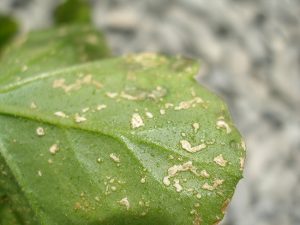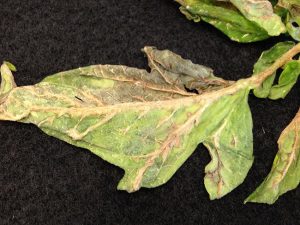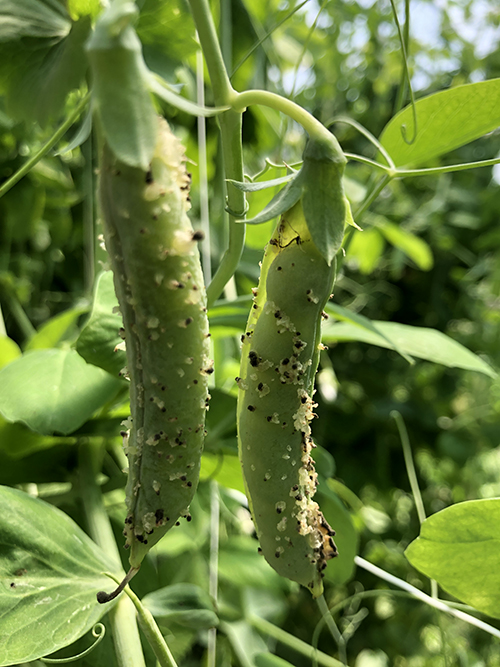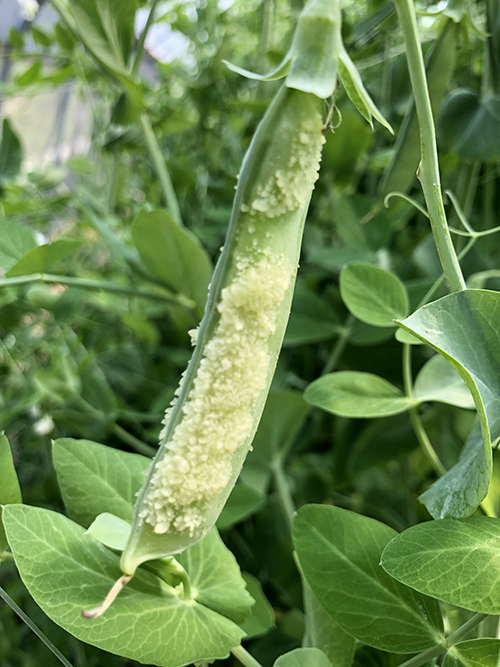Bulletin #5059, Too Much Water or Not Enough Light? Irregular Growth Commonly Seen on Plants Grown Indoors
Developed by Dr. Alicyn Smart, Assistant Extension Professor & Extension Plant Pathologist, University of Maine Cooperative Extension, and Nick Goltz, Graduate Student, University of Florida.
For information about UMaine Extension programs and resources, visit extension.umaine.edu.
Find more of our publications and books at extension.umaine.edu/publications/.
Edema (Oedema)
Abiotic Disorder: Swollen growths or corky lesions on leaves and/or stems.
Introduction
Edema is a symptom of excessive watering. It is most common with houseplants, plants grown in greenhouses or under plastic, and plants grown too close to one another. With plants grown outdoors, it is usually seen following cloudy, humid, or low-light conditions when the plant is not able to transpire quickly enough to relieve itself of excess moisture.
Symptoms & Signs

Edema usually manifests as raised bumps on stems or the lower side of leaves. These bumps are initially clear or greenish but will become tan and corky over time. Sometimes (particularly with succulents), the corky areas will not be raised and will appear as spotty lesions instead. See figure 1.
To learn more about edema, see University of Maine Cooperative Extension Bulletin #5060, Edema.
Etiolation
Abiotic Disorder: Long, spindly plant with pale leaves.
Introduction
Etiolation is very common among houseplants and plants grown outdoors in constant or near-constant shade. Genetics and overwatering do not appear to have an impact on etiolation.
Symptoms & Signs
Etiolation is the term used to describe plants with insufficient chlorophyll, elongated, spindly stems and pale leaves due to being grown in low-light conditions.
Intumescence
Abiotic Disorder: Swollen growths on surfaces (especially veins) of leaves.
Introduction
Unlike edema, intumescence does not appear to be caused solely by excess watering. Researchers have not arrived at a consensus on what causes intumescence development, but it is likely caused by a combination of excess water, not enough ultraviolet (UV) light and a genetic predisposition.
Symptoms & Signs

Symptoms of intumescence are similar to those of edema and the two terms are sometimes used interchangeably. The raised bumps that characterize intumescence are sometimes corky and are found on the leaf surface and along leaf veins. See figure 2. Intumescence is most common on solanaceous crops (tomato, sweet potato) grown in greenhouses.
Neoplasm
Abiotic Disorder: Improper planting or natural occurrence overtime
Introduction
While there is not much definitive evidence on the exact causes of neoplasm growth, they are likely caused by lack of ultraviolet (UV) light and a genetic predisposition. Excess watering does not seem to increase the likelihood of neoplasm formation, but they are more commonly found during cloudy, humid and low-light conditions.
Symptoms & Signs
Like intumescence, neoplasms are also swollen growths observed on a plant, usually on fruit or new growth. See figure 3 and Figure 4.


Management
- Providing a proper amount of water. For potted plants, only water when the topsoil is dry. Ensure that soil has good drainage and that pots have drainage holes to reduce the risk of damage from overwatering.
- Providing enough light. Even “low-light” plants benefit from some direct sunlight. Potted plants in the home should be kept in sunny areas near windows, and adequately spaced from one another to allow good airflow and proper access to light. If the amount of sunlight in the home is not sufficient, plants may be moved to sunnier locations outdoors gradually (high temperatures and too much direct sun may cause sun scald). Slowly expose it to increasing amounts of sun over a period of several days (e.g. one hour indirect sunlight on day 1, two hours on day 2, etc.) Plants experiencing etiolation should be acclimated to sunlight in this way as well.
References
1. Agrios, George N. Plant Pathology. 4th ed. 1997. Academic Press. 1 August 2020.
2. The American Phytopathological Society (APS). nd. Water. https://www.apsnet.org/edcenter/apsnetfeatures/Pages/Water.aspx
3. Craver J.K., Miller C.T., Gabriela Cruz, M. and K.Williams. 2014. Intumescences: Further Investigations into an Elusive Physiological Disorder. Greenhouse Product News. 24(9), Sept.issue pp 32,34, 36, 37,38,40.
4. Joy and Hudelson. 2012. Edema. UW-Madison Plant Pathology Extension Fact Sheet XHT1116
Information in this publication is provided purely for educational purposes. No responsibility is assumed for any problems associated with the use of products or services mentioned. No endorsement of products or companies is intended, nor is criticism of unnamed products or companies implied.
© 2021
Call 800.287.0274 (in Maine), or 207.581.3188, for information on publications and program offerings from University of Maine Cooperative Extension, or visit extension.umaine.edu.
In complying with the letter and spirit of applicable laws and pursuing its own goals of diversity, the University of Maine System does not discriminate on the grounds of race, color, religion, sex, sexual orientation, transgender status, gender, gender identity or expression, ethnicity, national origin, citizenship status, familial status, ancestry, age, disability physical or mental, genetic information, or veterans or military status in employment, education, and all other programs and activities. The University provides reasonable accommodations to qualified individuals with disabilities upon request. The following person has been designated to handle inquiries regarding non-discrimination policies: Director of Institutional Equity and Title IX Services, 5713 Chadbourne Hall, Room 412, University of Maine, Orono, ME 04469-5713, 207.581.1226, TTY 711 (Maine Relay System).

